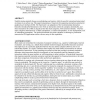Free Online Productivity Tools
i2Speak
i2Symbol
i2OCR
iTex2Img
iWeb2Print
iWeb2Shot
i2Type
iPdf2Split
iPdf2Merge
i2Bopomofo
i2Arabic
i2Style
i2Image
i2PDF
iLatex2Rtf
Sci2ools
HCI
2001
2001
Identifying Critical Interaction Scenarios for Innovative User Modeling
Usability testing typically focuses on methodology and metrics, while the specific interactions being tested are chosen in an ad hoc way. This paper demonstrates a framework for organizing interaction scenarios for l user interfaces (GUI). The framework is an adaptation of the two-dimensional abstraction hierarchy introduced by Rasmussen [1] in which an interaction consists of a purpose, functionality, and form. Interactions for a GUI are organized into four main categories, with numerous subtasks. The four main categories determined are 1) object manipulation, 2) content manipulation, 3) view manipulation, and 4) information presentation. The general framework can guide evaluators in choosing key interaction scenarios for GUI applications across a diverse array of user capabilities.
| Added | 31 Oct 2010 |
| Updated | 31 Oct 2010 |
| Type | Conference |
| Year | 2001 |
| Where | HCI |
| Authors | V. Katie Emery, Julie A. Jacko, Thitima Kongnakorn, Vipat Kuruchittham, Steven Landry, George McLeland Nickles, Andrew Sears, Justin Whittle |
Comments (0)

